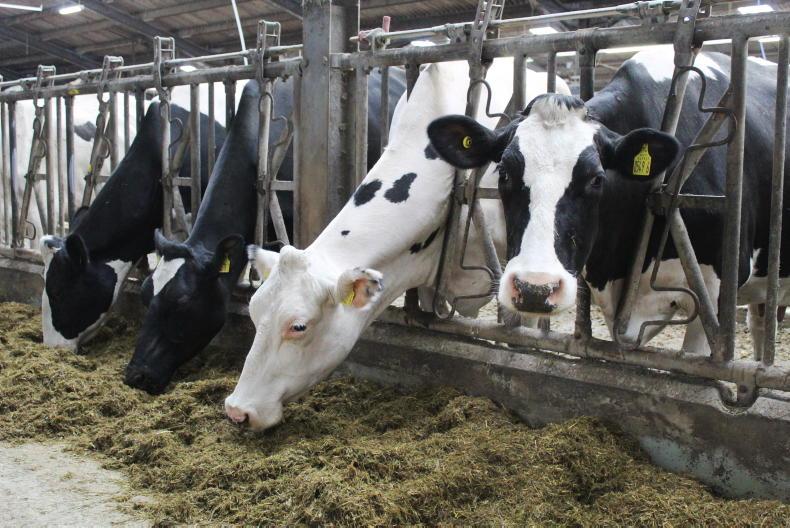The size of the move in shares of Glanbia following the announcement of annual results last week will likely have come as a shock to management at Tirlán.
Last September, they were looking at building an investment fund valued at €658m using 41.4m shares in Glanbia.
Those same 41.4m shares were worth just over €431m this week, a loss of more than €200m in value.
Tirlán’s total holding of Glanbia shares amounts to approximately 75.5m shares, with the 34m shares not earmarked for the investment fund mostly consisting of those shares scheduled for the spinout to members in May and those which are used as collateral for the €250m bond – due to be repaid in January 2027.
When members voted for the spinout in October last year, the average value of that was put at €24,600. In the wake of last week’s tumble in the share price, that average is now closer to €17,000.
For Tirlán, there is something of a double-hit from the drop in Glanbia’s share price due to the 2027 bond. In short: the bond is backed by 15.1m Glanbia shares which are to be used towards paying back the €250m when it comes due in January 2027. The maths are fairly simple on this. If the shares are worth €16.55 or more on the repayment date, then the bond holders will just take the 15.1m Glanbia shares in full payment of the bond.
However, if the shares are worth less than €16.55, Tirlán will have to make up the difference. At €10.40 a share, the shares are worth €169m. This would leave €93m to be made up by Tirlán from elsewhere.
The obvious place for that is the co-op’s investment fund. At €10.40 a share, that value is €431m, so taking €93m off further reduces the value of the fund to €338m. That’s a long way from the €658m valuation given back in September. To put the size of that loss into context, that €320m is larger than the value of shares used by Kerry Co-op in the purchase of Kerry Dairy Ireland on the last day of 2024.
Outlook
While there may be considerable dismay about the size and speed of the drop in Glanbia shares, it is important to remember that the share price only really matters to Tirlán when they are sold. The plunge has not cost Tirlán anything in real terms, it just means that the co-op’s balance sheet is smaller. However, Tirlán does have ambitions to diversify its investment holding, so to meet that plan it will have to reduce its Glanbia holding eventually.
Also, there will be a forced sale on the day the 2027 bond comes due.
The share spinout in May will not crystallise any losses for either the co-op or the members receiving the shares – again those losses will only be realised when/if the shares are sold in the market.
Needless to say, a recovery in Glanbia’s share price will benefit both Tirlán and the co-op’s members. While we are making absolutely no prediction here about how that share price will develop over the coming months and years, there are some reasons to be hopeful that the worst is over for now.
The forecast of lower earnings for 2025 – which was one of the big drivers of the share-price collapse – seems to have been substantially driven by higher-than-expected whey prices at the end of 2024. There are reasons to believe that price spike will be a transitory event, with considerable extra production coming on stream in the US later this year and in 2026. This should allow some margin recovery and the potential for higher earnings in future.
The off-loading of underperforming businesses like SlimFast should allow management concentrate more on the profitable parts of the business and maximise returns there. Glanbia’s current multi-year group-wide transformation programme is targeting annual cost savings of at least €50m per year by 2027.
However, the return of the share price to highs seen in June of last year where it traded above €19 does not seem likely in the short term.
Investors will need to see some real improvement from Glanbia before they are willing to put their money back into a company which so roundly disappointed in its annual results.
Glanbia is still a ‘high-value’ problem
Though it may not feel like it this week for the management and members of Tirlán, the co-op continues to be in a very strong financial position due to its Glanbia shareholding. The huge drop in the value of those shares does not translate into a cost for the co-op, and has no effect on its cashflow or operating profit.
Tirlán, following the Kerry Co-op deal, is now the only co-op in the country with a significant financial asset, meaning it has by far the largest balance sheet of any dairy processor.
While the move in the share price does mean that Tirlán’s future investment pool may be smaller, it’s still going to be in an enviable position by having one at all. For other processors, any complaints from Tirlán would be like listening to a rich person complain about getting a scratch on their Rolex.
The Glanbia shares may be worth less than they were, but they still provide a substantial financial safety net for Tirlán. The fluctuations in the share price between now and whenever the investment fund is up and running will decide how many hundreds of millions of euros the co-op will have for a rainy day. The problem for the co-op then will be what to do with those hundreds of millions – a problem any other processor in the country would love to have.
When contacted for a reaction to the share price moves, a spokesperson for Tirlán said the co-op had no comment at this point.
When Tirlán announced last year that it intended to use its Glanbia shares to set up an investment fund, one of the arguments the co-op put forward was the fund would reduce the risk from holding and single shareholding.
There was a sharp lesson last week in that risk when the value of the holding dropped by almost a quarter in a couple of trading sessions. While it is not unreasonable to expect that Glanbia’s share price will climb again over time, the size and speed of the move should only serve to galvanise Tirlán determination to find other investments.
For Tirlán members – many of whom already have substantial holdings in Glanbia shares - the tumble in value in recent days is obviously a disappointment, especially coming so close to the long-awaited spinout. However, as with all investments, the value of the shares only matters on the day they are sold and it has been typical for those members to hold, rather than sell, their Glanbia shares.
It may be in their interest to examine if they would be better off, longer term, by taking a similar tactic to Tirlán and diversifying their financial investments.
For the Glanbia management, there needs to be some lessons from the last week too. While the disappointing results may have been mostly driven by higher-than-expected whey prices, there are also underlying reasons for concern. The decision to sell SlimFast could have come a lot earlier than it did. The use of buybacks might help support the share price in the short term, but many investors would rather Glanbia used the money to grow the business and provide better long-term returns for them.
It is impossible to predict where Glanbia’s share price will go next, but everyone, from Tirlán to its members, to Glanbia management, should have learned some difficult lessons over the past week.
Tirlán has 75.5m Glanbia shares.They have seen a 28% drop in value in the last week.Loss since spinout was announced at more than €400m.2027 bond repayment will reduce investment fund.No cash cost to Tirlán from share moves.
The size of the move in shares of Glanbia following the announcement of annual results last week will likely have come as a shock to management at Tirlán.
Last September, they were looking at building an investment fund valued at €658m using 41.4m shares in Glanbia.
Those same 41.4m shares were worth just over €431m this week, a loss of more than €200m in value.
Tirlán’s total holding of Glanbia shares amounts to approximately 75.5m shares, with the 34m shares not earmarked for the investment fund mostly consisting of those shares scheduled for the spinout to members in May and those which are used as collateral for the €250m bond – due to be repaid in January 2027.
When members voted for the spinout in October last year, the average value of that was put at €24,600. In the wake of last week’s tumble in the share price, that average is now closer to €17,000.
For Tirlán, there is something of a double-hit from the drop in Glanbia’s share price due to the 2027 bond. In short: the bond is backed by 15.1m Glanbia shares which are to be used towards paying back the €250m when it comes due in January 2027. The maths are fairly simple on this. If the shares are worth €16.55 or more on the repayment date, then the bond holders will just take the 15.1m Glanbia shares in full payment of the bond.
However, if the shares are worth less than €16.55, Tirlán will have to make up the difference. At €10.40 a share, the shares are worth €169m. This would leave €93m to be made up by Tirlán from elsewhere.
The obvious place for that is the co-op’s investment fund. At €10.40 a share, that value is €431m, so taking €93m off further reduces the value of the fund to €338m. That’s a long way from the €658m valuation given back in September. To put the size of that loss into context, that €320m is larger than the value of shares used by Kerry Co-op in the purchase of Kerry Dairy Ireland on the last day of 2024.
Outlook
While there may be considerable dismay about the size and speed of the drop in Glanbia shares, it is important to remember that the share price only really matters to Tirlán when they are sold. The plunge has not cost Tirlán anything in real terms, it just means that the co-op’s balance sheet is smaller. However, Tirlán does have ambitions to diversify its investment holding, so to meet that plan it will have to reduce its Glanbia holding eventually.
Also, there will be a forced sale on the day the 2027 bond comes due.
The share spinout in May will not crystallise any losses for either the co-op or the members receiving the shares – again those losses will only be realised when/if the shares are sold in the market.
Needless to say, a recovery in Glanbia’s share price will benefit both Tirlán and the co-op’s members. While we are making absolutely no prediction here about how that share price will develop over the coming months and years, there are some reasons to be hopeful that the worst is over for now.
The forecast of lower earnings for 2025 – which was one of the big drivers of the share-price collapse – seems to have been substantially driven by higher-than-expected whey prices at the end of 2024. There are reasons to believe that price spike will be a transitory event, with considerable extra production coming on stream in the US later this year and in 2026. This should allow some margin recovery and the potential for higher earnings in future.
The off-loading of underperforming businesses like SlimFast should allow management concentrate more on the profitable parts of the business and maximise returns there. Glanbia’s current multi-year group-wide transformation programme is targeting annual cost savings of at least €50m per year by 2027.
However, the return of the share price to highs seen in June of last year where it traded above €19 does not seem likely in the short term.
Investors will need to see some real improvement from Glanbia before they are willing to put their money back into a company which so roundly disappointed in its annual results.
Glanbia is still a ‘high-value’ problem
Though it may not feel like it this week for the management and members of Tirlán, the co-op continues to be in a very strong financial position due to its Glanbia shareholding. The huge drop in the value of those shares does not translate into a cost for the co-op, and has no effect on its cashflow or operating profit.
Tirlán, following the Kerry Co-op deal, is now the only co-op in the country with a significant financial asset, meaning it has by far the largest balance sheet of any dairy processor.
While the move in the share price does mean that Tirlán’s future investment pool may be smaller, it’s still going to be in an enviable position by having one at all. For other processors, any complaints from Tirlán would be like listening to a rich person complain about getting a scratch on their Rolex.
The Glanbia shares may be worth less than they were, but they still provide a substantial financial safety net for Tirlán. The fluctuations in the share price between now and whenever the investment fund is up and running will decide how many hundreds of millions of euros the co-op will have for a rainy day. The problem for the co-op then will be what to do with those hundreds of millions – a problem any other processor in the country would love to have.
When contacted for a reaction to the share price moves, a spokesperson for Tirlán said the co-op had no comment at this point.
When Tirlán announced last year that it intended to use its Glanbia shares to set up an investment fund, one of the arguments the co-op put forward was the fund would reduce the risk from holding and single shareholding.
There was a sharp lesson last week in that risk when the value of the holding dropped by almost a quarter in a couple of trading sessions. While it is not unreasonable to expect that Glanbia’s share price will climb again over time, the size and speed of the move should only serve to galvanise Tirlán determination to find other investments.
For Tirlán members – many of whom already have substantial holdings in Glanbia shares - the tumble in value in recent days is obviously a disappointment, especially coming so close to the long-awaited spinout. However, as with all investments, the value of the shares only matters on the day they are sold and it has been typical for those members to hold, rather than sell, their Glanbia shares.
It may be in their interest to examine if they would be better off, longer term, by taking a similar tactic to Tirlán and diversifying their financial investments.
For the Glanbia management, there needs to be some lessons from the last week too. While the disappointing results may have been mostly driven by higher-than-expected whey prices, there are also underlying reasons for concern. The decision to sell SlimFast could have come a lot earlier than it did. The use of buybacks might help support the share price in the short term, but many investors would rather Glanbia used the money to grow the business and provide better long-term returns for them.
It is impossible to predict where Glanbia’s share price will go next, but everyone, from Tirlán to its members, to Glanbia management, should have learned some difficult lessons over the past week.
Tirlán has 75.5m Glanbia shares.They have seen a 28% drop in value in the last week.Loss since spinout was announced at more than €400m.2027 bond repayment will reduce investment fund.No cash cost to Tirlán from share moves. 









SHARING OPTIONS